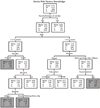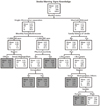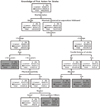Abstract
Purpose
This study was performed to explore levels of stroke knowledge and identify subgroups with lower levels of stroke knowledge among adults in Korea.
Methods
A cross-sectional survey was used and data were collected in 2012. A national sample of 990 Koreans aged 20 to 74 years participated in this study. Knowledge of risk factors, warning signs, and first action for stroke were surveyed using face-to-face interviews. Descriptive statistics and decision tree analysis were performed using SPSS WIN 20.0 and Answer Tree 3.1.
Results
Mean score for stroke risk factor knowledge was 7.7 out of 10. The least recognized risk factor was diabetes and four subgroups with lower levels of knowledge were identified. Score for knowledge of stroke warning signs was 3.6 out of 6. The least recognized warning sign was sudden severe headache and six subgroups with lower levels of knowledge were identified. The first action for stroke was recognized by 65.7 percent of participants and four subgroups with lower levels of knowledge were identified.
Figures and Tables
 | Figure 1Decision-tree model to identify the subgroups with lower levels of knowledge of risk factors for stroke. |
 | Figure 2Decision-tree model to identify the subgroups with lower levels of knowledge of warning signs for stroke. |
References
1. Statistics Korea. 2011 Cause of death [Internet]. Daejeon: Author;2012. cited 2013 April 26. Available from: http://kostat.go.kr/portal/korea/kor_nw/2/6/2/index.board?bmode=read&aSeq=260046.
2. Health Insurance Review & Assessment Service. 2012 Disclosure of cardiocerebrovascular disease evaluation results [Internet]. Seoul: Author;2012. cited 2013 April 26. Available from: http://www.hira.or.kr/dummy.do?pgmid=HIRAA020041000000&cmsurl=/cms/notice/02/1214308_13390.html.
3. Clinical Research Center for Stroke. Clinical practice guidelines for stroke. 2nd ed. Seoul: Author;2013.
4. Yu KH, Bae HJ, Kwon SU, Kang DW, Hong KS, Lee YS, et al. Analysis of 10,811 cases with acute ischemic stroke from Korean stroke registry: Hospital-based multicenter prospective registration study. J Korean Neurol Assoc. 2006; 24(6):535–543.
5. Kim YS, Park SS, Bae HJ, Cho AH, Cho YJ, Han MK, et al. Stroke awareness decreases prehospital delay after acute ischemic stroke in Korea. BMC Neurol. 2011; 11:2. http://dx.doi.org/10.1186/1471-2377-11-2.
6. Han NY, Ko EA, Hwang SY. Knowledge of stroke symptoms and risk factors among older adults. J Korean Acad Adult Nurs. 2009; 21(3):314–323.
7. Kim JS, Yoon SS. Perspectives of stroke in persons living in Seoul, South Korea. A survey of 1000 subjects. Stroke. 1997; 28(6):1165–1169.
8. Kim EM, Hwang SY, Kim AL. Knowledge of stroke and heart attack symptoms and risk factors among rural elderly people: A questionnaire survey. Korean Circ J. 2011; 41(5):259–264. http://dx.doi.org/10.4070/kcj.2011.41.5.259.
9. Bae SS. A research of workers' knowledge and educational needs on stroke [master's thesis]. Incheon: Gacheon Medical and Science School;2007.
10. Ennen KA, Zerwic J. Stroke knowledge: How is it impacted by rural location, age, and gender? Online J Rural Nurs Health Care. 2010; 10(1):9–21.
11. Hwang SY, Zerwic JJ. Knowledge of stroke symptoms and risk factors among Korean immigrants in the United States. Res Nurs Health. 2006; 29(4):337–344. http://dx.doi.org/10.1002/nur.20144.
12. Kim YS, Park SS, Bae HJ, Heo JH, Kwon SU, Lee BC, et al. Public awareness of stroke in Korea: A population-based national survey. Stroke. 2012; 43(4):1146–1149. http://dx.doi.org/10.1161/strokeaha.111.638460.
13. Sloma A, Backlund LG, Strender LE, Skåér Y. Knowledge of stroke risk factors among primary care patients with previous stroke or TIA: A questionnaire study. BMC Fam Pract. 2010; 11:47. http://dx.doi.org/10.1186/1471-2296-11-47.
14. Hickey A, Holly D, McGee H, Conroy R, Shelley E. Knowledge of stroke risk factors and warning signs in Ireland: Development and application of the Stroke Awareness Questionnaire (SAQ). Int J Stroke. 2012; 7(4):298–306. http://dx.doi.org/10.1111/j.1747-4949.2011.00698.x.
15. Moreira E, Correia M, Magalhães R, Silva MC. Stroke awareness in urban and rural populations from northern Portugal: Knowledge and action are independent. Neuroepidemiology. 2011; 36(4):265–273. http://dx.doi.org/10.1159/000328867.
16. Lutfiyya MN, Ng L, Asner N, Lipsky MS. Disparities in stroke symptomology knowledge among US midlife women: An analysis of population survey data. J Stroke Cerebrovasc Dis. 2009; 18(2):150–157. http://dx.doi.org/10.1016/j.jstrokecerebrovasdis.2008.09.009.
17. Lundelin K, Graciani A, García-Puig J, Guallar-Castillón P, Taboada JM, Rodríguez-Artalejo F, et al. Knowledge of stroke warning symptoms and intended action in response to stroke in Spain: A nationwide population-based study. Cerebrovasc Dis. 2012; 34(2):161–168. http://dx.doi.org/10.1159/000341408.
18. Yang J, Zheng M, Cheng S, Ou S, Zhang J, Wang N, et al. Knowledge of stroke symptoms and treatment among community residents in western urban China. J Stroke Cerebrovasc Dis. 2013; pii: S1052-3057(13)00429-1. http://dx.doi.org/10.1016/j.jstrokecerebrovasdis.2013.10.019.
19. Choi JH, Han ST, Kang H, Kim ES, Kim MK, Lee SK. Data mining prediction and utilization by using Answer Tree 3.0. Seoul: SPSS Academy;2006.
20. Han ST, Kang H, Choi H, Do JD, Shin SH. A study on development of customer attrition model in financial institution data. J Korean Data Anal Soc. 2009; 11(1):279–288.
21. World Stroke Organization. World stroke campaign [Internet]. Geneva: Author;2011. cited 2011 March 17. Available from: http://www.worldstrokecampaign.org/2011/learn/Documents/wsd_brochureUpdate1.pdf.
22. Korean Stroke Society. You can win if you know the symptoms [Internet]. Seoul: Author;2011. cited 2011 March 20. Available from: http://www.stroke.or.kr/bbs/index.html?code=day&category=&gubun=&page=2&number=22&mode=view&order=&sort=&keyfield=&key=&page_type.
23. Clinical Research Center for Stroke. Clinical practice guidelines for stroke. Seoul: Author;2009.
24. Goldstein LB, Bushnell CD, Adams RJ, Appel LJ, Braun LT, Chaturvedi S, et al. Guidelines for the primary prevention of stroke: A guideline for healthcare professionals from the American Heart Association/American Stroke Association. Stroke. 2011; 42(2):517–584. http://dx.doi.org/10.1161/STR.0b013e3181fcb238.
25. Waltz CF, Strickland OL, Lenz ER. Measurement in nursing research. 2nd ed. Philadelphia, PA: F. A. Davis;1991.
26. Ministry of Public Administration and Security. 2011 Statistical yearbook [Internet]. Seoul: Author;2011. cited 2012 January 10. Available from: http://www.mospa.go.kr/frt/bbs/type001/commonSelectBoardArticle.do?bbsId=BBSMSTR_000000000013&nttId=35503.
27. Huh MH. SPSS statistics classification analysis. Seoul: Data Solution;2012.
28. Cameron V. Best practices for stroke patient and family education in the acute care setting: A literature review. Medsurg Nurs. 2013; 22(1):51–55. 64
29. Wolf PA, D'Agostino RB, O'Neal MA, Sytkowski P, Kase CS, Belanger AJ, et al. Secular trends in stroke incidence and mortality. The Framingham Study. Stroke. 1992; 23(11):1551–1555.
30. Health Insurance Review & Assessment Service. Acute stroke adequacy assessment [Internet]. Seoul: Author;2009. cited 2012 April 30. Available from: http://www.hira.or.kr/dummy.do?pgmid=HIRAA020041000000&cmsurl=/cms/notice/02/1195341_13390.html.




 PDF
PDF ePub
ePub Citation
Citation Print
Print





 XML Download
XML Download